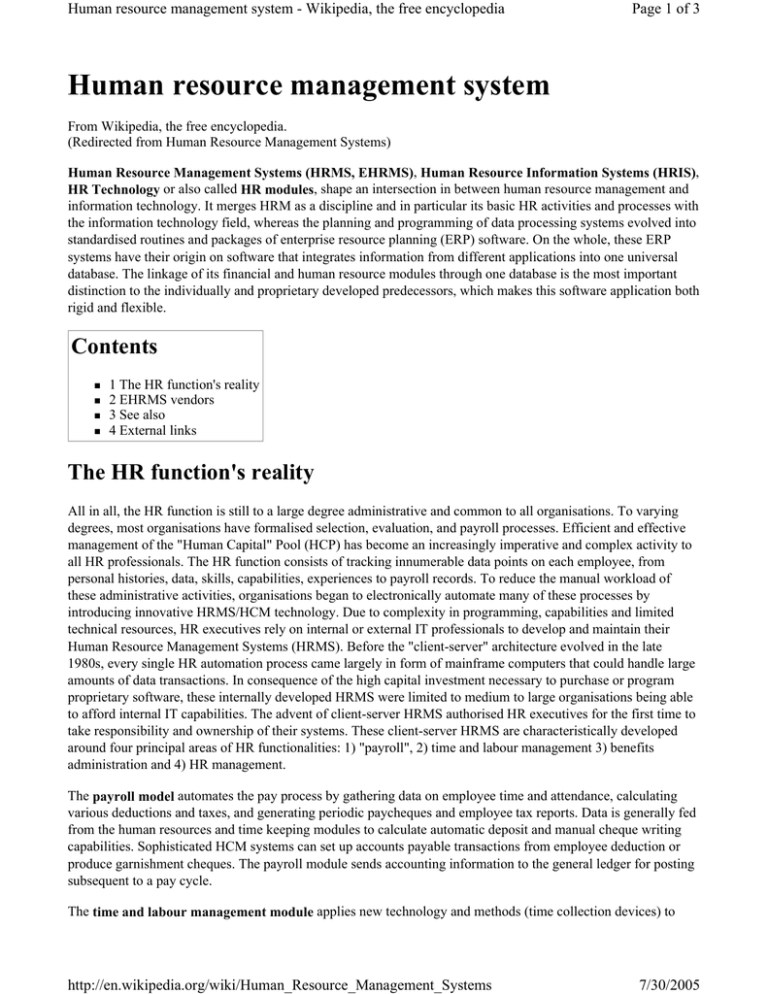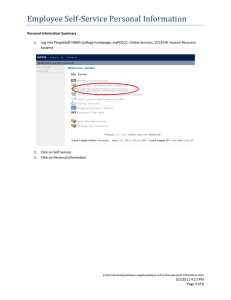Human resource management system Page 1 of 3
advertisement

Human resource management system - Wikipedia, the free encyclopedia Page 1 of 3 Human resource management system From Wikipedia, the free encyclopedia. (Redirected from Human Resource Management Systems) Human Resource Management Systems (HRMS, EHRMS), Human Resource Information Systems (HRIS), HR Technology or also called HR modules, shape an intersection in between human resource management and information technology. It merges HRM as a discipline and in particular its basic HR activities and processes with the information technology field, whereas the planning and programming of data processing systems evolved into standardised routines and packages of enterprise resource planning (ERP) software. On the whole, these ERP systems have their origin on software that integrates information from different applications into one universal database. The linkage of its financial and human resource modules through one database is the most important distinction to the individually and proprietary developed predecessors, which makes this software application both rigid and flexible. Contents 1 The HR function's reality 2 EHRMS vendors 3 See also 4 External links The HR function's reality All in all, the HR function is still to a large degree administrative and common to all organisations. To varying degrees, most organisations have formalised selection, evaluation, and payroll processes. Efficient and effective management of the "Human Capital" Pool (HCP) has become an increasingly imperative and complex activity to all HR professionals. The HR function consists of tracking innumerable data points on each employee, from personal histories, data, skills, capabilities, experiences to payroll records. To reduce the manual workload of these administrative activities, organisations began to electronically automate many of these processes by introducing innovative HRMS/HCM technology. Due to complexity in programming, capabilities and limited technical resources, HR executives rely on internal or external IT professionals to develop and maintain their Human Resource Management Systems (HRMS). Before the "client-server" architecture evolved in the late 1980s, every single HR automation process came largely in form of mainframe computers that could handle large amounts of data transactions. In consequence of the high capital investment necessary to purchase or program proprietary software, these internally developed HRMS were limited to medium to large organisations being able to afford internal IT capabilities. The advent of client-server HRMS authorised HR executives for the first time to take responsibility and ownership of their systems. These client-server HRMS are characteristically developed around four principal areas of HR functionalities: 1) "payroll", 2) time and labour management 3) benefits administration and 4) HR management. The payroll model automates the pay process by gathering data on employee time and attendance, calculating various deductions and taxes, and generating periodic paycheques and employee tax reports. Data is generally fed from the human resources and time keeping modules to calculate automatic deposit and manual cheque writing capabilities. Sophisticated HCM systems can set up accounts payable transactions from employee deduction or produce garnishment cheques. The payroll module sends accounting information to the general ledger for posting subsequent to a pay cycle. The time and labour management module applies new technology and methods (time collection devices) to http://en.wikipedia.org/wiki/Human_Resource_Management_Systems 7/30/2005 Human resource management system - Wikipedia, the free encyclopedia Page 2 of 3 cost effectively gather and evaluate employee time/work information. The most advanced modules provide broad flexibility in data collection methods, as well as labour distribution capabilities and data analysis features. This module is a key ingredient to establish organisational cost accounting capabilities. The benefit administration model permits HR professionals to easily administer and track employee participation in benefits programs ranging from healthcare provider, insurance policy, and pension plan to profit sharing or stock option plans. The HR management module is a component covering all other HR aspects from application to retirement. The system records basic demographic and address data, selection, training and development, capabilities and skills management, compensation planning records and other related activities. Leading edge systems provide the ability to "read" applications and enter relevant data to applicable database fields, notify employers and provide position management and position control. Typically, HRMS/HCM technology replaces the four core HR activities by streamlining them electronically; 1) payroll, 2) time and labour management, 3) benefit administration and 4) HR management. While using the internet or corporate intranet as a communication and workflow vehicle, the HRMS/HCM technology can convert these into web-based HRMS components of the ERP system and permit to reduce transaction costs, leading to greater HR and organisational efficiency. Through employee or manager self-service (ESS or MSS), HR activities shift away from paper based processes to using self-service functionalities that benefit employees, managers and HR professionals alike. Costly and time consuming HR administrative tasks, such as travel reimbursement, personnel data change, benefits enrolment, enrolment in training classes (employee side) and to instruct a personnel action, authorise access to information for employees (manager's side) are being individually handled and permit to reduce HR transaction time, leading to HR and organisational effectiveness. Consequently, HR professionals can spend fewer resources in managing administrative HR activities and can apply freed time and resources to concentrate on strategic HR issues, which lead to business innovation. EHRMS vendors Vendors of popular EHRMS enterprise level software packages include : SAP, PeopleSoft, Oracle, Lawson A wide variety of other software vendors provide various subsets of enterprise level functionality. For example, basic time and attendance software packages provide employee timekeeping functionality while other vendors focus primarily on payroll processing. See also Applicant tracking system list of management topics list of human resource management topics list of information technology management topics Computer science Enterprise resource planning Labour (economics) Process management human interaction management Reengineering Management information systems Management process http://en.wikipedia.org/wiki/Human_Resource_Management_Systems 7/30/2005 Human resource management system - Wikipedia, the free encyclopedia Page 3 of 3 External links Management Research on EHRMS (http://www.ehrms.com/) EHRMS News (http://www.ehrms.com/blog) Retrieved from "http://en.wikipedia.org/wiki/Human_resource_management_system" Categories: Management | Organizational studies and human resource management | Information technology management This page was last modified 07:22, 26 July 2005. All text is available under the terms of the GNU Free Documentation License (see Copyrights for details). http://en.wikipedia.org/wiki/Human_Resource_Management_Systems 7/30/2005


